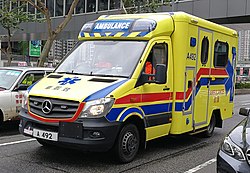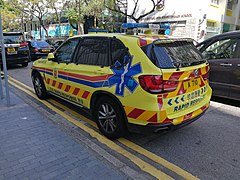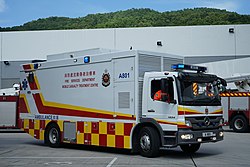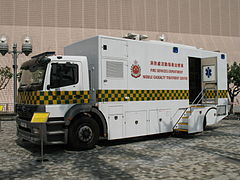Emergency medical services in Hong Kong
Ambulance Services in Hong Kong are provided by the Hong Kong Fire Services, in co-operation with two other voluntary organisations, the Auxiliary Medical Service and the Hong Kong St. John Ambulance.
Public hospitals have charged HK$100 for treatment at accident and emergency departments since 2002. About 2.2 million use the service each year. Waiting time varies between one hour and more than five hours. In 2017 it was decided to increase the cost to HK$180 with an expansion of the fee waiver mechanism. The actual cost per patient is about HK$1,230.[when?][1] HK$1,390 in 2017-2018[2]
The ambulance service from the Hong Kong Fire Service pledges to have an arrival of an ambulance at the street address from the time of call within 12 minutes.[3]
Organisation
The Hong Kong Fire Service is the statutory provider of emergency ambulance service in Hong Kong, as mandated by
The statutory service is supplemented by two organisations –
Air Ambulance
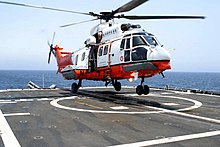
In Hong Kong, all
Standards
Vehicles
The majority of ambulances in Hong Kong are originally of British design; a reflection of Hong Kong's long association with Britain. As a result, the design of the majority of ambulances approximately corresponds to the
- Typical EMS Vehicles in Hong Kong
-
Hong Kong Fire Service ambulance, in its updated yellow livery
-
Hong Kong Fire Service rapid response vehicle
-
Hong Kong Fire Service mobile casualty treatment centre, a kind of ambulance bus
-
Hong Kong Fire Services ambulance BMW R1200RT
-
An ambulance of thePeople's Liberation Army Hong Kong Garrison, in which it also operates its internal medical and sanitary system
-
Mercedes-Benz Sprinter (Second Generation) Auxiliary Medical Services Ambulance
-
Mercedes-Benz Sprinter St John Ambulance
-
A Mercedes-Benz Axor truck belonging to the Hong Kong Fire Services Department
Training and staffing
Although the Hong Kong Fire Service maintains that its ambulances provide
Dispatch
As with many things in Hong Kong, the dispatch of emergency vehicles continues to be influenced by the British legacy. The telephone number for emergency services throughout Hong Kong is 999, just as in Britain. All 999 calls are answered by the Hong Kong Police Force. If an ambulance is the only response required, the call is passed directly to Hong Kong Fire Services dispatchers. If the call information is complex, as with a traffic accident, the police dispatchers will notify the ambulance service when they suspect that ambulances might be required. Both ambulances and fire apparatus are co-dispatched by the Hong Kong Fire Service dispatchers.[13] The system operates technologies and decision support software that are approximately equivalent with those found in Europe and North America.
Response times
The objective of the Hong Kong Fire Service is to have an ambulance on the scene of an emergency within twelve minutes of receiving the request, 24 hours per day. They are currently achieving that objective on more than 93 percent of all emergency calls. The current dispatch system in Hong Kong does not categorise ambulance calls by medical acuity, although there are plans to introduce this measure in the future.[14]
See also
Hong Kong's Emergency Services
- Hong Kong Police Force
- Hong Kong Fire Services Department
- Auxiliary Medical Services
- Hong Kong St. John Ambulance
- Government Flying Service
- Civil Aid Service
References
- ^ "Higher charges can ease burden on A & E wards at public hospitals". South China Morning Post. 21 April 2017. Retrieved 24 April 2017.
- ^ https://www.legco.gov.hk/research-publications/english/1819in05-emergency-care-services-in-selected-places-20190131-e.pdf
- ^ "Performance Pledge". Hong Kong Fire Services Department. Retrieved 23 July 2018.
- ^ "Hong Kong: The Facts (HKFS website) 1" (PDF). Retrieved 25 September 2008.
- ^ "Hong Kong: The Facts (HKFS website) 2" (PDF). Retrieved 25 September 2008.
- S2CID 31020961.
- ^ "Government Flying Service website". Retrieved 25 September 2008.
- ^ "European Committee for Standards website". Retrieved 19 September 2008.,
- ^ "Full Implementation of Paramedic Ambulance Service (HKFS document)". Retrieved 25 September 2008.
- ^ "Duties of an Ambulance Man/Woman (HKFS website)". Retrieved 25 September 2008.
- PMID 11025847.
- ^ "International EMS Survey 1". Retrieved 25 September 2008.
- PMID 11025847.
- ^ "How to Call an Ambulance (HKFS document)". Retrieved 25 September 2008.

